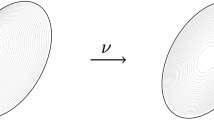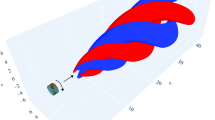Abstract
A novel active control concept aimed at mixing enhancement of an axisymmetric incompressible jet was investigated experimentally. The lip of the jet was equipped with evenly distributed small flaps, or flaplets, deflected away from the stream at an angle of 30°. Controlled attachment of the jet’s boundary layer to the flaps was achieved by introducing zero mass-flux perturbations through control slots located at the base of the flaps, yielding a radial deflection of the shear layer. As a result, pairs of strong streamwise vortices of a finite length were periodically generated and shed in phase with the control signal. At a Strouhal number of 0.3 based on the nozzle diameter, the perturbations also regulated the shedding of spanwise vortex rings. Hot-wire measurements in the vicinity of the flaplets as well as phase-averaged stereoscopic PIV measurements at various streamwise locations were employed to elucidate the mechanism of controlled attachment and to map the evolution of the coherent structures. The strength of axial vorticity was strongly dependent upon the control frequency. A semiempirical framework adopted to quantify the overall effect of control predicted a significant increase in mixing in the region close to the nozzle.

























Similar content being viewed by others
References
Bernal LP, Roshko A (1986) Streamwise vortex structure in plane mixing layers. J Fluid Mech 170:499–525
Bodony DJ (2005) The prediction and understanding of jet noise. Center for Turbulence Research Annual Research Briefs 367377
Breidenthal R (1981) Structure in turbulent mixing layers and wakes using a chemical reaction. J Fluid Mech 109:1–24
Bridges J, Brown CA, (2004) Parametric testing of chevrons on single flow hot jets. In: Technical report, NASA
Bridges J, Wernet M, Brown C (2003) Control of jet noise through mixing enhancement. In: Technical report, NASA
Brown CA, Bridges J (2006) Acoustic efficiency of azimuthal modes in jet noise using chevron nozzles. AIAA paper 2006–2645
Brown GL, Roshko A (1974) On density effects and large structure in turbulent mixing layers. J Fluid Mech 64:775–816
Callender B, Gutmark E, Martens S (2005) Far-field acoustic investigation into chevron nozzle mechanisms and trends. AIAA J 43(1):87–95
Carr LW (1988) Progress in analysis and prediction of dynamic stall. J Aircr 25(1):6–17
Collis SS, Lele SK, Moser RD, Rogers MM (1994) The evolution of a plane mixing layer with spanwise nonuniform forcing. Phys Fluids 6:381
Crow SC, Champagne FH (1971) Orderly structure in jet turbulence. J Fluid Mech 48:547–591
Darabi A, Wygnanski I (2004) Active management of naturally separated flow over a solid surface. Part 1. The forced reattachment process. J Fluid Mech 510:105–129 and Part 2. The separation process. J Fluid Mech 510:131–144
Greenblatt D (2005) Management of vortices trailing flapped wings via separation control. AIAA paper no. 2005–2061
Greenblatt D (2006) Managing flap vortices via separation control. AIAA J 44(11):2755–2764
Greenblatt D (2007) Dual location separation control on a semispan wing. AIAA J 45(8):1848–1860
Greenblatt D (2012) Fluidic control of a wing tip vortex. AIAA J 50(2):375–386
Greenblatt D, Wygnanski I (2000) Control of flow separation by periodic excitation,”. Prog Aerosp Sci 36(7):487–545
Greenblatt D, Wygnanski I (2003) Effect of leading-edge curvature on airfoil separation control. J Aircr 40(3):473–481
Greenblatt D, Singh Y, Kastantin Y, Nayeri CN, Paschereit CO (2007) Active management of entrainment and streamwise vortices in an incompressible jet. Active Flow Control 95:281–292
Greenblatt D, Singh Y, Nayeri CN, Paschereit CO, Mohan NKD (2008) Active control of an incompressible axisymmetric jet. ASME paper no. ESDA2008-59509
Grinstein FF, Gutmark EJ, Parr TP, Hanson-Parr D, Obeysekare U (1996) Streamwise and spanwise vortex interaction in an axisymmetric jet. A computational and experimental study. Phys Fluids 8:1515–1524
Gutmark EJ, Grinstein FF (1999) Flow control with noncircular jets. Ann Rev Fluid Mech 31:239–272
Gutmark EJ, Schadow KC, Yu KH (1995) Mixing enhancement in supersonic free shear flows. Annu Rev Fluid Mech 27:375–417
Hilgers A, Boersma BJ (2001) Optimization of turbulent jet mixing. Fluid Dyn Res 29(6):345–368
Huang LS, Maestrello L, Bryant TD (1987) Separation control over airfoils at high angles of attack by sound emanating from the surface. AIAA paper no. 1987–1261
Huerre P, Monkewitz PA (1985) Absolute and convective instabilities in free shear layers. J Fluid Mech 159:151–168
Hussain AKMF (1986) Coherent structures and turbulence. J Fluid Mech 173:303–356
Kamran MA, McGuirk JJ (2011) Subsonic jet mixing via active control using steady and pulsed control jets. AIAA J 49(4):712–724
Katz Y, Nishri B, Wygnanski I (1989) The delay of turbulent boundary layer separation by oscillatory active control. AIAA paper no. 1989–0975
Katz Y, Nishri B, Wygnanski I (1989) The Delay of turbulent boundary layer separation by oscillatory active control. AIAA paper no. 1989–0975
Kinzie K, Henderson B, Whitmire J, Abeyshinghe A (2004) Fluidic chevrons for jet noise reduction. Active 04, Williamsburg, Virginia, September 20–22, United States
Kinzie K, Henderson B, Whitmire J, Abeyshinghe A (2004) Fluidic chevrons for jet noise reduction. Active 04
Knowles K, Saddington AJ (2006) A review of jet mixing enhancement for aircraft propulsion applications. J Aerosp Eng 220:103–127
Laurendeau E, Jordan P, Bonnet J, Delville J, Parnaudeau P, Lamballais E (2008) Subsonic jet noise reduction by fluidic control: the interaction region and the global effect. Phys Fluids 20:101519. doi:10.1063/1.3006424
Liepmann D, Gharib M (1992) The role of streamwise vorticity in the near-field entrainment of round jets. J Fluid Mech 245:643–668
Marble FE, Zukoski EE, Jacobs JW, Hendricks GJ, Waitz IA (1990) Shock enhancement and control of hypersonic mixing and combustion. AIAA paper no. 1990–1981
Mohan NKD, Greenblatt D, Nayeri CN, Paschereit CO, Nagangudy Ramamurthi P (2008) Active and passive flow control of an incompressible axisymmetric jet. P ASME turbo expo 2008
Müller-Vahl H, Singh Y, Greenblatt D, Nayeri CN, Paschereit CO (2010) Active control of an incompressible axisymmetric jet using zero mass-flux excitation. ICJWSF2010
Nishri B, Wygnanski I (1998) Effects of periodic excitation on turbulent flow separation from a flap. AIAA J 36(4):547–556
Papamoschou D, Rostamimonjezi S (2012) Modeling of noise reduction for turbulent jets with induced asymmetry. AIAA paper no. 2012–2158
Paschereit CO, Oster D, Long TS, Fiedler HE, Wygnanski I (1992) Flow visualization of interactions among large coherent structures in an axisymmetric jet. Exp Fluids 12(3):189–199
Paschereit CO, Wygnanski I, Fiedler HE (1995) Experimental investigation of subharmonic resonance in an axisymmetric jet. J Fluid Mech 283:365–407
Raupach MR, Antonia RA, Rajagopalan S (1991) Rough-wall turbulent boundary layers. Appl Mech Rev 44(1):1–25
Reynolds WC, Parekh DE, Juvet PJD, Lee MJD (2003) Bifurcating and blooming jets. Annu Rev Fluid Mech 35:295–315
Rotta J (1972) Statistical theory of inhomogeneous turbulence, part 1. NASA TT F-14, 560
Schlinker RH, Simonich JC, Shannon DW, Reba RA, Colonius T, Gudmundsson K, Ladeinde F (2009) Supersonic jet noise from round and chevron nozzles: experimental studies. AIAA paper no. 2009–3257
Singh Y, Greenblatt D, Nayeri CN, Paschereit CO (2009) Active control of an incompressible axisymmetric jet using flaps. TSFP-6, Turbulence and Shear Flow Phenomena, Seoul, Korea
Tamburello AD, Amitay M (2006) Manipulation of an axisymmetric jet using continuous control jets. J Turbul 7(59):1–24
Tamburello DA, Amitay M (2007) Three-dimensional interactions of a free jet with a perpendicular synthetic jet. J Turbul 8(38):1–21
Thomas RH, Choudhari MM, Joslin RD (2002) Flow and noise control: review and assessment of future directions. In: Technical report, NASA
Violato D, Scarano F (2011) Three-dimensional evolution of flow structures in transitional circular and chevron jets. Phys Fluids 23:124104
Waitz IA, Qiu YJ, Manning TA, Fung AKS, Elliot JK, Kerwin JM, Krasnodebski JK, O’Sullivan MN, Tew DE, Greitzer EM, Marble FE, Tan CS, Tillman TG (1997) Enhanced mixing with streamwise vorticity. Prog Aerosp Sci 33(5–6):323–351
Winant CD, Browand FK (1974) Vortex pairing: the mechanism of turbulent mixing-layer growth at moderate Reynolds number. J Fluid Mech 63:237–255
Zaman KBMQ, Bridges JE, Huff DL (2010) Evolution from ‘tabs’ to ‘chevron technology’—a review. In: Proceedings of the 13th Asian congress of fluid mechanics, Dhaka
Zhang S, Schneider SP (1995) Quantitative molecular-mixing measurements in a round jet with tabs. Phys Fluids 7:1063
Acknowledgments
The authors gratefully acknowledge the financial support for the work provided by the Deutsche Forschungsgemeinschaft (DFG), project number Pa 920/4-1. The assistance of Yogesh Singh is greatly appreciated.
Author information
Authors and Affiliations
Corresponding author
Electronic supplementary material
Below is the link to the electronic supplementary material.
Rights and permissions
About this article
Cite this article
Müller-Vahl, H., Nayeri, C.N., Paschereit, C.O. et al. Mixing enhancement of an axisymmetric jet using flaplets with zero mass-flux excitation. Exp Fluids 56, 38 (2015). https://doi.org/10.1007/s00348-014-1889-z
Received:
Revised:
Accepted:
Published:
DOI: https://doi.org/10.1007/s00348-014-1889-z




